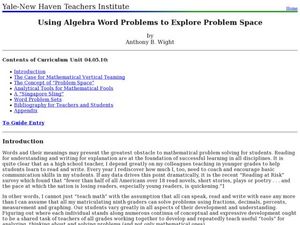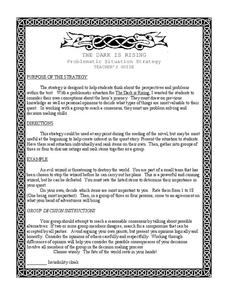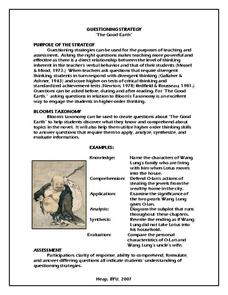Curated OER
Using Wordless Comics To Help Create Meaning in Reading
Use picture cues as a tool in order to create meaning along with text. With a wordless comic, young illustrators discuss the main idea and character traits, and independently write a summary for a page of a wordless comic. This strategy...
Illustrative Mathematics
Many Ways to Do Addition
A great aspect of teaching math is that children have the freedom to solve problems using a variety of different strategies. The focus of this lesson is for young mathematicians to become aware of many ways of answering addition...
Novelinks
The Good Earth: Biopoem Strategy
To gain a better understanding of characters in Pearl Buck's The Good Earth, kids create a biopoem for one of her characters.
Curated OER
Reading Comprehension: History of the Periodic Table
Although the article that launches this lesson is about the history of the Periodic Table, the objective is reading comprehension. Using the eight-page informational text, learners answer five comprehension questions and craft one essay....
Curated OER
Unit 1: Water is Life: The Heart and Science Behind this Phrase
Water, water, everywhere — but will there be enough to drink? Check out these detailed lesson plans to meet NGSS water cycle and CCSS literacy standards in your science classroom. Learners do a close reading of a challenging, poetic text...
Curated OER
Sense and Sensibility Vocabulary Strategy: Desk Top Teaching
Amicably dispel “the prejudices of…young mind(s)” by exposing them to the language of Jane Austen. Readers of Sense and Sensibility use desk-top strategies to teach one another the vocabulary from this classic romance novel. The resource...
Curated OER
Introduce Vocabulary: Alexander, Who Use to be Rich Last Sunday (Viorst)
Although this vocabulary-in-context activity is focused on Judith Viorst's book Alexander, Who Use to Be Rich Last Sunday, the strategy can be applied to any book budding learners read with you. First, introduce the three new words you...
Curated OER
Using Algebra to Explore Problem Space
Students apply their knowledge of math by rewriting word problems using equations. In this word problem lesson, students build upon previous knowledge as they set up the correct steps to solve word problems. This lesson is full of hints...
K5 Learning
The Moon
Second graders read a short informational text passage about the moon and answer a series of questions based on what they read.
EngageNY
Notices, Wonders, and Vocabulary of the Third Stanza of “If”
How does one's experience reading a poem's text differ from listening to its audio version? Delve into the insightful question with the poem, If by Rudyard Kipling, as pupils compare and contrast their experience using a note-taking...
Texas Education Agency (TEA)
Cognates (English III Reading)
Did you know that "30-40 percent of all words in English have a related word in Spanish?" This fact launches an interactive study of cognates appearing the same in English and Spanish. Learners demonstrate what they have learned about...
Texas Education Agency (TEA)
Simile and Metaphor (English III Reading)
The key idea in this interactive exercise designed for high schoolers is that figurative language, especially similes, and metaphors, add layers of meaning to a text. Users examine examples from speeches, ads, movie dialogue, and poems,...
Curated OER
Rosencrantz and Guildenstern Are Dead: Pre-Reading Strategy
Get your class ready to read Rosencrantz and Guildenstern Are Dead by Tom Stoppard with an anticipation guide. This document describes exactly how to create and implement an anticipation guide.
Mr. Nussbaum
Redwood National Park Reading Comprehension
An interactive tests scholars' reading comprehension skills. Young learners read an informative passage about redwood trees then respond to five questions. Feedback appears instantly.
Curated OER
Wuthering Heights: Questioning Strategy
Readers of Wuthering Heights use the DRTA strategy to formulate predictions about the actions of characters in Bronte's novel.
Novelinks
The Crucible: Questioning Strategies Bloom's Taxonomy
Enrich your unit on Arthur Miller's The Crucible with a list of reading questions based on Bloom's Taxonomy. Kids answer questions and provide context for the knowledge, comprehension, application, analysis, synthesis, and evaluation...
Novelinks
The Book Thief: Cubing Strategy
Whether used to review prior to a reading assessment or as a way to generate ideas for an essay, this activity is sure to encourage critical thinking about Markus Zusak's The Book Thief. Kids create a six-sided question cube with each...
Novelinks
The Adventures of Tom Sawyer: Directed Reading Thinking Activity
Guide your pupils through The Adventures of Tom Sawyer with a directed reading exercise. The teacher asks questions as the class reads a chapter to help lead learners toward making well-supported predictions.
Novelinks
Tuck Everlasting: Discussion Web Strategy
Guide learners through a discussion about Natalie Babbitt's Tuck Everlasting with a helpful graphic organizer. As they read through the novel, individuals note their reactions to statements about the book's themes, and fill out a chart...
Brigham Young University
Out of the Dust: KWHL Strategy
A K-W-H-L chart is a great way to scaffold prior knowledge. As class members begin their reading of Out of the Dust, Karen Hesse’s 1998 Newbery Medal winning verse novel, they chart what they already know about the Great Depression and...
Novelinks
The Dark Is Rising: Problematic Situation Strategy
What items would you need to save the world from an evil wizard? Prior to reading Susan Cooper's young adult contemporary fantasy The Dark is Rising, and to generate interest in the tale, class groups must reach consensus on a list of...
Curated OER
The Grapes of Wrath: KWHL Strategy
Before beginning The Grapes of Wrath, readers create a KWHL chart recording what they already know about the Dust Bowl, the author, and the book, what they want to know, and where they might find answers to these questions. After reading...
Novelinks
The Good Earth: Questioning Strategy
Readers use Bloom's Taxonomy to create multi-level questions about Pearl Buck's The Good Earth.
Curated OER
Making a Ten
An addition table supports third graders as they learn strategies to improve their math fluency. When finding sums greater than ten, students are taught how to first make a ten and then add on the rest. A similar method is also...

























